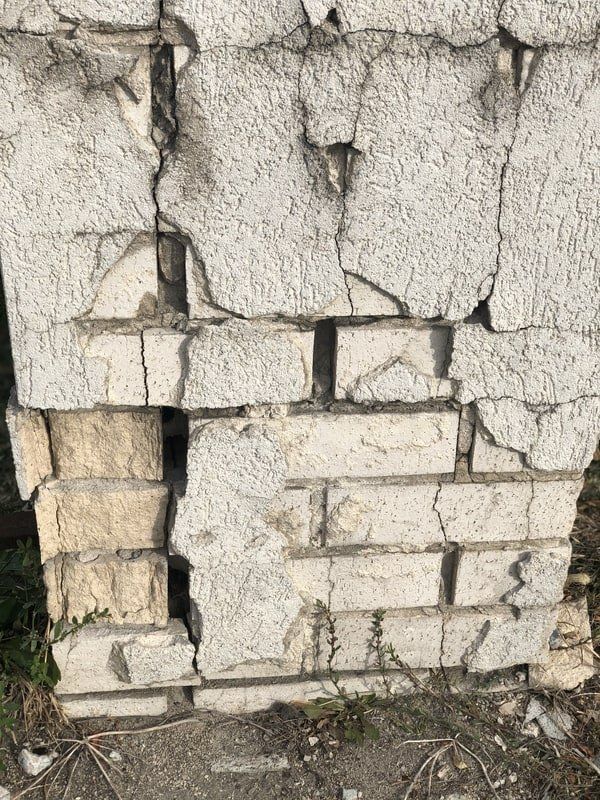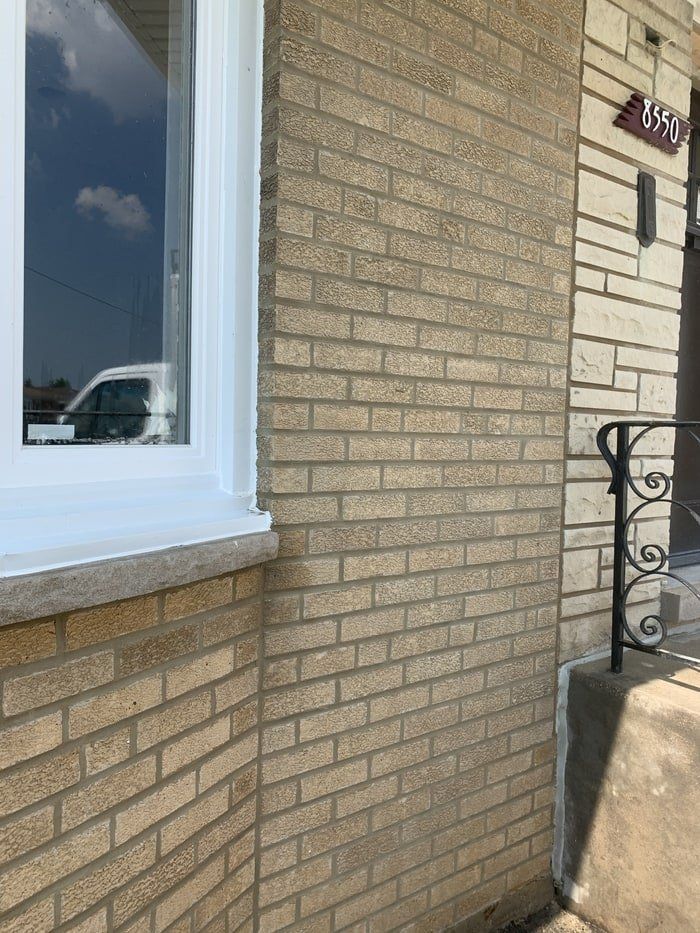The reasons why your limestone foundation is crumbling
Limestone is one of the most excellent construction materials that has been used for thousands of years. In fact, the mostly intact Pyramid of Giza, which is one of the 7 Wonders of the World, is made of limestone. Because it is a natural sedimentary rock, it is widely used and can be found throughout most of the country. It is likely the first commonly used building material due to its availability here in the United States. As a construction material, it is often made into a crushed stone and then typically turned into cement.
Though limestone is highly praised for its durability, there will come a time where it will deteriorate. This is absolutely normal, though it takes much longer for structures made of limestone material compared to concrete, the mortar will eventually lose its strength and damages may be apparent, such as cracks and crumbling.
If your home is made of limestone and you are seeing crumbling on its foundation, chances are high that it is an old structure that your family had for years, or you recently bought it and you are planning to have it fixed. Before you inspect your limestone foundation for damage, and what we should do to get it fixed, the first thing you need to do is inspect and locate the reason why your limestone foundation is crumbling.
What are the causes for limestone foundations to crumble?
There are many possible reasons why your limestone foundation is crumbling, and these are the most common:
- Exposure to weathering
Chemical weathering is one of the most common causes of damage. One example of weathering is when rainwater, which reacts with the calcium carbonate found in limestone, makes the water acidic from the carbonic acid in it. The more they are exposed to each other, the faster your limestone will deteriorate faster. This would mean that limestone foundations will be more susceptible to break in places where rain is more plentiful.
- Absorption of oils and other materials
Limestone absorbs organic and inorganic oils, like the droppings of animals around the neighborhood, metals like copper and iron, and paints. Aside from crumbling, these are also the main causes of the unwanted and ugly stains to your foundation.
- Exposure to moisture
Water is almost always the number one enemy of construction materials, especially stonewalls. Frequent exposure to liquids will make your limestone brittle. This is mainly because of its water-permeable structure, which would mean that the limestone will also absorb the dampness and it will penetrate on its pores.
- Passage of time
Like all things, deterioration will come for the limestone. It is expected for limestone to gradually breakdown as time passes because that’s just how time works. However, with proper maintenance and repair if needed, it would be possible for limestone to last longer.
- Biological Activity
Biological growth, such as plants, algae, fungi, and bacteria, can establish colonies on the limestone foundation. In humid or shaded areas, these organisms can take root in cracks and crevices. As they grow, their expansion can widen existing cracks, while biological secretions contribute to the chemical breakdown of the limestone.
What are the preventive measures?
1. Water Management
To counter water infiltration, implement effective drainage systems, gutters, and downspouts to direct water away from the foundation. Regular maintenance ensures the proper function of these systems.
2. Sealing and Waterproofing
Apply suitable sealants and waterproofing materials to shield the limestone surface from water infiltration and chemical reactions.
3. Regular Inspections
Conduct frequent inspections to detect cracks, erosion, and signs of settling at an early stage. Timely identification allows for prompt intervention.
4. Professional Restoration
For substantial deterioration, seek the expertise of professionals in limestone restoration. They can assess the extent of damage and perform necessary restoration work.
5.Site Analysis
Prior to construction, conduct a comprehensive site analysis. Ensure proper soil compaction, implement appropriate drainage systems, and adhere to sound construction practices to minimize foundation issues.
How do I know if it's crumbling or not?
It is actually easy to know if your limestone foundation is already starting to deteriorate as it can be seen by your naked eye. You just need to inspect your walls and look for the following signs:
1. There is a white powdery substance on your wall
Run your fingers on the inside of your wall and look for a white powder-like substance.
2. There are cracks, scratches, and discoloration on your stone
Look at your stonewall and search for cracks and chipping.
3. There are missing parts or parts of crumbling mortar on the floor
Inspect your foundation for signs of erosion, some of the chippings may have fallen on your floor. When you are done assessing your foundation, you can now look for the best ways to fix it.
How do you fix a crumbling foundation?
There are many ways to repair or fix a crumbling limestone foundation. The best way to repair it would depend on the scope of work necessary. Here are some of the most common methods used by professionals to repair your limestone foundation:
1. Cleaning
To remove the absorbed oils and other materials in your limestone that can also cause it to crumble, cleaning is recommended.
How it is commonly done: Cleaning your limestone wall should be done gently using a low-pressure spray of purified water with a hose. Make sure to not use any other kind of water because it can damage your wall further.
2. Repointing
This method is used to fill in new mortar in lieu of the old cracked mortar.
How it is commonly done: The damaged mortar is partially chipped so that it can be filled in with a new lime-based mortar by packing it into the joints of the old material.
3. Patching
This technique is usually done if your limestone foundation has minimal areas of damage.
How it is commonly done: Using a lime-based mortar, it will be applied in many layers until the small areas of cracks are covered.
4. Sculpting
This technique is mostly used if your limestone foundation has larger cracks and damages
How it is commonly done: Though commonly done for aesthetic purposes, sculpting is combined with other repair methods to carve the badly damaged parts of the stone.
How to Solve the Problem?
1. Hire a Professional
Bringing in a professional, such as a structural engineer or a foundation specialist, is essential to properly diagnose the issues with your limestone foundation. They will conduct a thorough assessment, determine the root causes of the problem, and recommend appropriate solutions.
Example: Suppose you notice significant cracks and crumbling in your limestone foundation. By hiring a structural engineer, they can assess the extent of the damage, analyze soil conditions, and identify whether the issues are due to natural settling, poor construction practices, or other factors.
2. Improve Drainage
Water infiltration is a common cause of foundation deterioration. Enhancing the drainage around your property helps prevent excess water from accumulating near the foundation.
Example: If you observe pooling water around the base of your home after rainfall, it's an indication of poor drainage. By installing properly functioning gutters, downspouts, and grading the landscape away from the foundation, you can redirect rainwater and prevent it from saturating the soil around the foundation.
3. Reinforce Weak Sections
Strengthening weak or vulnerable sections of the foundation is crucial to preventing further damage. This can involve adding support structures to enhance stability.
Example: If you notice cracks forming around a specific section of your foundation, a foundation specialist might recommend installing steel braces or wall anchors to reinforce that area and distribute the load more evenly, preventing the cracks from expanding.
4. Repair Damaged Areas
Immediate repairs are necessary to address the visible damage to the foundation. Proper repairs can restore the foundation's integrity and prevent moisture infiltration.
Example: If you find sections of your limestone foundation with visible cracks and crumbling, you could use epoxy injections to fill the cracks and restore the structural integrity. Mortar repairs can also be used to rebuild eroded sections and ensure the foundation's stability.
5. Repairs to Existing Structure
Specific repairs aimed at restoring the appearance and functionality of the foundation can be important for maintaining its overall strength.
Example: If your limestone foundation has weathered surfaces and rough textures due to erosion, professionals can apply specialized techniques to smooth the surface and restore its original appearance, while also addressing the structural issues.
How can you maintain your limestone foundation properly to prevent it from crumbling?
1. Address Water Issues
Ensure that your property has effective drainage systems in place. Clean and maintain gutters, downspouts, and drainage channels to prevent water from accumulating near the foundation. Make sure water is directed away from the foundation to avoid excessive moisture infiltration.
2. Control Moisture
Keep the soil around your foundation adequately watered but avoid overwatering, which can lead to soil expansion and contraction. Avoid planting large trees close to the foundation, as their roots can extract moisture and potentially cause soil movement.
3. Monitor Grading
Regularly inspect the slope and grading around your foundation. The ground should slope away from the foundation to prevent water from pooling against it. If you notice improper grading, consider regrading the landscape.
4. Seal and Protect
Apply appropriate sealants and waterproof coatings to the limestone surface to protect it from water infiltration and chemical reactions. Consult with professionals to select the right products for your specific type of limestone.
5. Address Cracks Promptly
If you spot any cracks, even small ones, address them promptly. Cracks can allow water to penetrate the foundation and cause further damage over time. Use suitable materials like epoxy injections or mortar repairs to fill and seal the cracks.
6. Professional Inspection
Every few years, consider hiring a professional to conduct a comprehensive inspection of your foundation. Their expertise can identify underlying issues that may not be immediately visible.
7. Vegetation Management
Trim back vegetation, especially plants and trees, that are too close to the foundation. Roots can penetrate cracks and accelerate deterioration. Keep the area around the foundation clear to facilitate proper airflow and prevent moisture buildup.
8. Pest Control
Regularly inspect for pests like termites and ants, which can exploit cracks and weaknesses in the foundation. If you notice any signs of infestation, address it promptly with appropriate pest control measures.
9. Avoid Harsh Cleaning Methods
When cleaning the foundation, use gentle methods such as brushing or low-pressure washing. Harsh cleaning agents or high-pressure washing can damage the surface of the limestone.
10. Document Changes
Keep records of your inspections, maintenance, and any repairs you've undertaken. This documentation can help you track the condition of your foundation over time and assist professionals if issues arise.
Should I worry?
When they see crumbling on their limestone foundation, many people don’t get that worried. After all, limestone is known to be durable and is even the material used in the most popular buildings such as The Pentagon, Washington National Cathedral, and even the Empire State Building. What we need to know is that these buildings are regularly maintained to make sure that it is safe for people to go into.
If you see signs of damage in your limestone foundation, no matter how small or large, you should have it addressed right away. Small problems turn into much larger ones if you don’t have them addressed by a professional. If you find yourself in need of a mason who works with limestone, give us a call. We would be happy to take a look and provide a free estimate to make your stone look like new.



